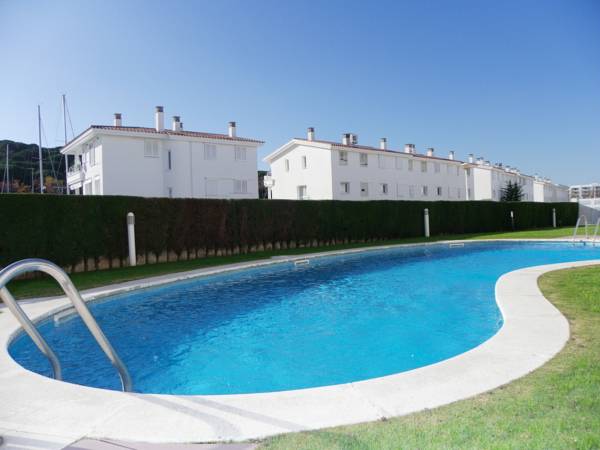
Chic Apartments Port d´Aro , 3 rooms
From: To: Availability
Chic Apartments Port d'Aro is located in Platja d'Aro and offers a shared salt-water pool and a garden. The beach is 5 minutes' walk from the property.
Featuring a private terrace overlooking the marina, the air-conditioned apartment has 2 twin bedrooms, 1 double bedroom, and 2 bathrooms with a shower. There is a living space with a flat-screen TV and DVD player, while the kitchen is quipped with a dishwasher, microwave, Nespresso coffee machine, and oven.
At Chic Apartments Port D'Aro you will find a garden surrounding the pool. Activities such as horse riding, golf, tennis, and cycling can be done in the surroudings. Girona-Costa Brava Airport is located 32 km from the property, and Barcelona is 105 km away.
Chic Apartments Port d´Aro is in Platja d'Aro
Platja d’Aro’s main drag, formed by Avinguda S’Agaró and Avinguda Cavall Bernat, offers some of the region’s best shopping, with big-name designer clothes stores and some classy local establishments. Most are open all year and have extended summer hours (daily 10am–2pm & 5–10pm).
As evening suffuses into night, the pavement cafés become a popular spot for an aperitif and some prime people-watching. Later into the night a hedonistic crowd moves in, as the stylish, laid-back bars and thumping discos get going.
Every February, the same streets play host to one of the Costa Brava’s best Carnival processions, with floats and extravagant fancy-dress parades accompanied by revelry all weekend long.
On the northern edge of town is Ciutat de Palol, a small square that was the site of a wine- and oil-producing Roman villa, in use between the first century BC and the seventh century AD. Badly neglected during the tourism boom, it has now been properly excavated and saved, and what little remains has been laid out as a public area with seating.
Almost the entire length of Platja d’Aro’s beach is backed by an uneven toothy grin of high-rise blocks, interspersed with some older low-rise buildings, fronted by a pedestrianized promenade with terraces and restaurants.The sweep of coarse golden sand, shelving moderately steeply into clear water, sees families and firm-bodied clubbers working on their tans.The southern tip of Platja Gran, marked by the chic Port Nàutic and capped by the Punta de Pinell headland, gets slightly less crowded.
At the northern end of the Platja Gran, three incongruous-looking nineteenth-century villas are a reminder of how the town has changed, while 100m further on is the huge standing stone known as El Cavall Bernat, the backdrop to free summer jazz concerts. Its name came into use in the sixteenth century as a euphemism for the original Carall Bernat, thought to mean “revered phallus” (“carall” is Catalan for “phallus”).
North of Platja d’Aro, the Camí de Ronda footpath dips and climbs for 4km, from the north- ern end of the Platja Gran along the water’s edge as far as Sant Antoni de Calonge, offering paths down to some beautiful beaches.A number can also be reached by footpaths off the C253 road towards Palamós, which has roadside parking.
The first you come to is the attractive, busy Cala Rovira, originally the Roman port for the area. It’s also known as Cala dels Escalencs after the fishing families from L’Escala, who – until the advent of tourism in the 1950s – used to spend their summers here camped on the beach, fishing the waters and selling their catch in Sant Feliu de Guíxols.A terrifically colourful and emotive fiesta to mark this history takes place on the first weekend after the Diada holiday (Sept 11), when dozens of traditional Vela Llatina boats make the journey from L’Escala and families camp on the beach in makeshift shelters for two days of traditional crafts, havaneres and cremat.
Neighbouring Cala Sa Cova offers a gently shelving beach and safe bathing up to a clearly defined line of underwater rocks, and its pretty setting amid pines helps you to overlook the number of people. Smaller and more inviting is Cala del Pi, 200m further north along the Camí de Ronda; its underwater rocks and craggy point make it perfect for snorkelling.A long tunnel separates this from Ses Rodones de Terra, where stone steps lead down through clumps of bamboo to a rugged mosaic of boulders and beach, a favourite with nude bathers.
Further along the footpath, Cala Belladona is less busy than its neighbours, and you’ll find good snorkelling and swimming a long way out into the steeply shelving sea. Finally, Platja de Can Cristus, most easily reached from the road, has a good sandy beach, but can get crowded owing to the presence of two large campsites nearby.
Map and how to arrive

- Apartments(27)
-
 Villas(7)
Villas(7)
- Campings(4)
- Hotels(25)
- Beaches(6)
- Feast days(3)
- Roman villas(1)
- Nature reserve(1)
- Megaliths(1)












































